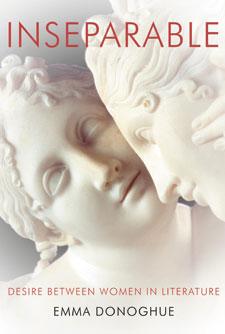There’s no denying that the lesbian literary tradition is a peculiar one. From ambiguous friendships to angst-ridden coming-out stories, finding common ground in such a disparate landscape takes a certain amount of imagination. But Emma Donoghue likes a challenge. The London, Ontario, author, critic and scholar is Canada’s high priestess of queer history, with a resumé that includes both bestselling novels and critically acclaimed nonfiction.
Her new book, Inseparable: Desire Between Women in Literature, is a real labour of love — one that’s been in the works for nearly 15 years. “Every year I’d spend a couple of months in the library reading, say, all the restoration comedies that had any whiff of crossdressing in them,” she says, with a grin. “It was sheer pleasure for me, but sometimes I’d think, This is ridiculous…. Nobody will ever publish it!”
Happily, Random House Canada has just proved her wrong. Inseparable is a highly enjoyable romp through literary history that reads like good journalism rather than academic textbook. It establishes a literary heritage we may not have realized we had. “A lot of people would say, ‘What tradition of lesbian literature? I don’t see it,’” says Donoghue. “But there’s such a continuity in the actual storylines, I think it’s perfectly justifiable to call it a tradition. It’s just a bit of a buried one.”
Donoghue takes six of the most popular girl-girl plots and shows how they are written — and rewritten — by different authors. They range from what she labels “Travesties” (in which “crossdressing causes the ‘accident’ of same-sex desire”) to “Monsters” (where “a wicked woman tries to seduce and destroy an innocent one”). Donoghue casts her literary net very wide, from heavyweights like Dickens, Shakespeare and Brontë to lesser-known authors such as LT Meade and Henry Rider Haggard.
These lesbian plots often appeared in unusual places. Uber-conservative Rider Haggard, for example, was known for his macho adventure stories set in Africa. His work was the last place Donoghue expected to find girl-on-girl action. “Allan’s Wife is about a lesbian baboon woman who’s passionately in love with our heroine, a delicate white girl,” says Donoghue, with a laugh. “[It’s a] really dodgy, politically incorrect text… and yet Rider Haggard gives the baboon woman these speeches in which she has so much dignity.”
Once Donoghue had identified her top six plots, she started seeing them everywhere. “I was astonished by how often a text that we think is original would turn out to have a forebear from a few years beforehand,” she says. She began to see a pattern: using a familiar story was often a way dealing with the unfamiliar. “Ooh, I don’t know how to handle that lesbian subject, so I’ll do it by reprising that plot,” says Donoghue. “They did a huge amount of that.”
She also found that modern texts — written after “lesbian” was established as an identity — weren’t necessarily more liberated. In fact, it was quite the opposite. “The past is a wild party,” she writes in the introduction, “check your preconceptions at the door.” For example, the passionate friendships that developed between women in the 18th century were granted social status. “You’d see astonishing declarations of eternal love from one woman to another,” says Donoghue. “The kind of thing that your girlfriend would laugh at you for saying nowadays.”
It’s refreshing that the book is generally unconcerned with the authors’ own sexuality. After all, the age-old “Is she or isn’t she?” debate soon gets tired if there’s no real answer to the question. Donoghue’s great skill is that she remains totally focused on her six plots through an amazingly broad time period — from medieval to modern. “Too many of the arguments about lesbian history have been either based on too few texts or fretting about a particular short period in time,” she says. “Lesbians have become so culturally confident in the last 10 years, it really allows for a book like this; one that says let’s get on with celebrating and exploring the wealth of our literary history.”
Inseparable isn’t just aimed at the queer community, though. Donoghue is hoping to challenge the preconception that gay and lesbian history is a specialist subject. “It’s just a slightly unusual angle on a very rich Euro and American literature,” she says. “I no longer want there to be giggles and titters when someone says they’re reading a book about lesbian history.” It’s an ambitious goal, but she might just pull it off. Including so many well-known novels, ones that are already a part of our cultural history, is a brilliant tactic. It has the dizzying effect of bringing something that’s always been in our shared peripheral vision — hazy and intangible until now — sharply into focus.

 Why you can trust Xtra
Why you can trust Xtra


